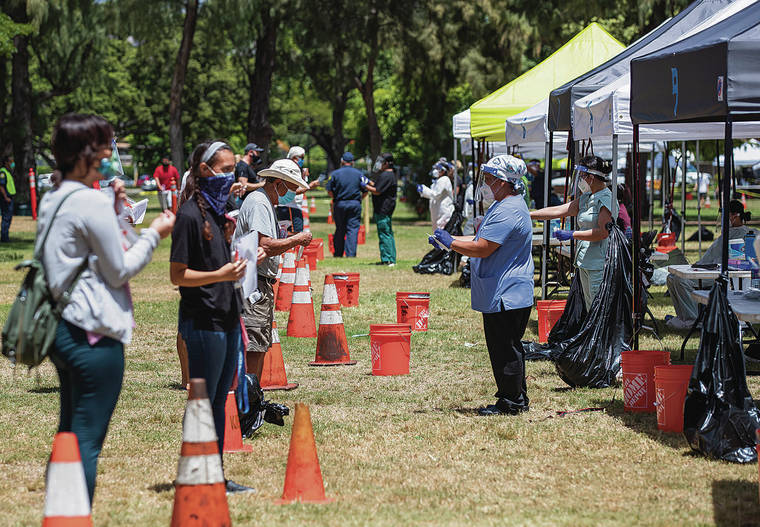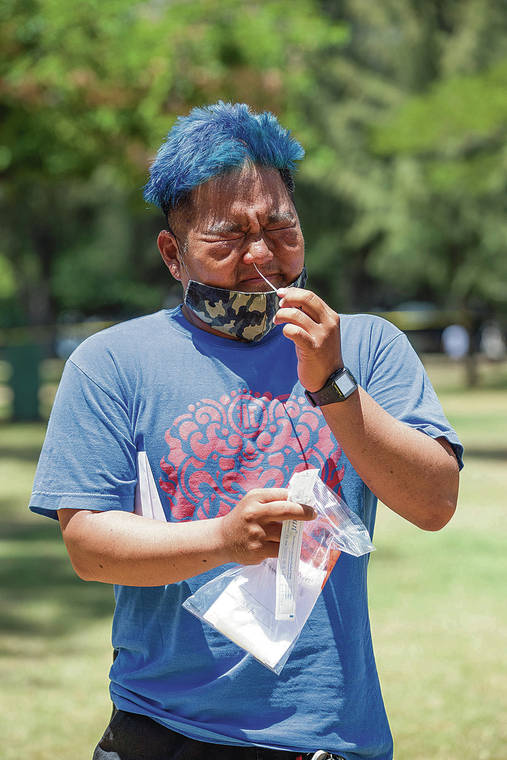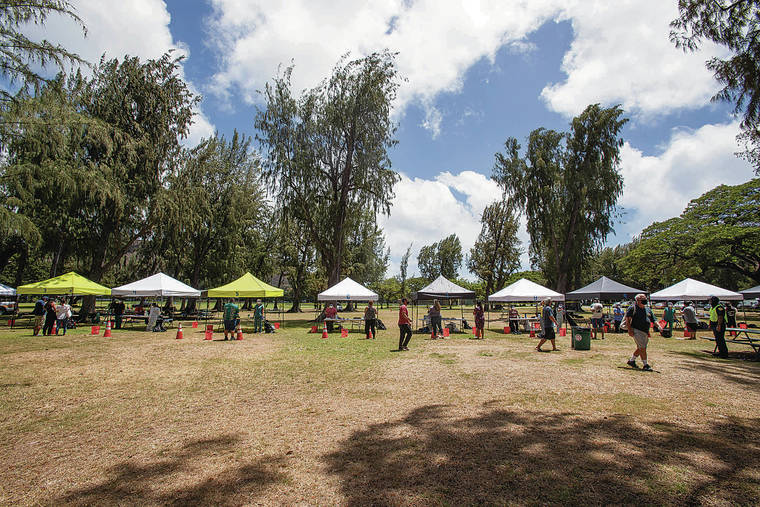Officials say Hawaii’s health care system is under great stress

CINDY ELLEN RUSSELL / CRUSSELL@STARADVERTISER.COM
People received instructions from health care workers on how to take the free federal test.

CINDY ELLEN RUSSELL / CRUSSELL@STARADVERTISER.COM
Kevin Jang self administered a COVID-19 test Monday at Kapiolani Regional Park.

CINDY ELLEN RUSSELL / CRUSSELL@STARADVERTISER.COM
COVID-19 surge testing tents were lined up Monday at Kapiolani Regional Park.



Hawaii hospital officials said Monday that the state’s health care system has been able to handle the state’s COVID-19 surge so far by shifting personnel, recruiting new workers, modifying hospital spaces and working long hours.
But the system is clearly under a great stress and continues to reach out for help under the growing weight of the pandemic, health care officials told members of the state Senate COVID-19 Committee.
“It’s not that we don’t have a bed. It’s the number of staff we need. It’s the number of nurses and clinicians we need,” said Jill Hoggard Green, president and CEO of The Queen’s Health Systems.
“Our staff are tired,” she said. “They’re working double shifts. They’re working tirelessly to care for every patient that has a need.”
PHOTOS: COVID-19 surge testing continues at Queen Kapiolani Regional Park Opens in a new tab
The comments were made as state health officials reported 133 new cases and seven fatalities on the deadliest day in the state’s battle against the coronavirus pandemic.
Don't miss out on what's happening!
Stay in touch with breaking news, as it happens, conveniently in your email inbox. It's FREE!
It was a tumultuous day that saw the announced retirements of embattled state Health Director Bruce Anderson and Public Safety Department director Nolan Espinda, whose Oahu Community Correctional Center generated the state’s largest cluster of virus cases.
In addition, Honolulu Mayor Kirk Caldwell defended his management of the federally funded surge testing program, which saw more than 1,700 Oahu residents told they must retake their tests due to test tube mislabeling at the Kaneohe District Park and Leeward Community College testing sites.
On the positive side, Caldwell announced that the feds would be sending 30,000 additional coronavirus tests to Oahu and that surge testing would be extended until Sept. 14.
The seven fatalities announced Monday capped a month in which the death toll in Hawaii ballooned from 26 to 70.
Five of the new COVID-19 deaths were Oahu residents, while the two others were from Hawaii island. They were reported Sunday night by the Hilo Medical Center.
The Oahu victims — men between the ages of 60 and over 80, and a woman in her 60s — were said to have had underlying health conditions and were hospitalized.
The Big Island’s first two coronavirus-related deaths, both men over the age of 80, were tied to an outbreak at the Yukio Okutsu State Veterans Home.
Officials reported 1,463 new tests taken Monday. With 133 positive cases, the positivity rate reached 9%.
Lt. Gov. Josh Green said there were 297 confirmed or suspected COVID-19 patients in Hawaii hospitals.
“Hospitalizations do translate to fatalities,” he said.
Meanwhile, Gov. David Ige said he believes the state will have to live with the virus for at least the next 12 months.
“The virus won’t disappear magically,” Ige said.
Hawaii residents will have to continue to modify their lives to deal with the pandemic while continuing to wear masks, keeping their distance and comply with mandates such as Oahu’s 14-day stay-at-home order.
“That’s the only way we can keep our case counts down. That’s the only way we can begin to reopen our economy. That’s the only way we can get to the new normal that is required with this coronavirus,” the governor said on the Honolulu Star-Advertiser’s Spotlight Hawaii digital broadcast.
Meanwhile, Hoggard Green of Queen’s and Andrew Giles of Kaiser Permanente Hawaii told the Senate COVID-19 Committee on Monday that the recent surge in virus patients has stretched hospital staffs on Oahu to their limits.
Hoggard Green said she was on the phone this weekend with federal health officials, the Federal Emergency Management Agency and the Hawaii Emergency Management Agency trying to rustle up some caregivers.
After recently putting out an urgent call for nurses and getting a response from hundreds of professionals, the Healthcare Association of Hawaii is now requesting an additional 150 caregivers.
The plan, Hoggard Green said, is to open up additional beds at smaller hospitals to accommodate COVID-19 patients in recovery mode, allowing for additional capacity for critical patients.
She said Queens is requesting critical care nurses, 750 cases of the anti-viral drug Remdesivir and thousands of boxes of N95 masks specially designed for those with smaller faces.
Hoggard Green said getting help from the feds has been complicated by other recent disasters, including hurricanes and wildfires.
“If we don’t get the support we need from HHS and FEMA, we will come to the state,” she told the senators. “We will have you on speed dial if we need additional support.”
Hoggard Green said Hawaii not only needs more testing, contact tracing and quarantining of those who have the disease, the state needs to step up its message regarding “personal accountability,” including mask wearing, hand washing and physical distancing.
She said the virus got out of hand on Oahu after people let their guard down.
Getting a flu shot is also key, she said. “If we don’t have flu shots at a rate over 75% this season, it could be devastating.”
“If all of us (took personal responsibility seriously), when we reopen — and we will reopen — we will be able to manage within the health system the individuals that need help,” she said.



